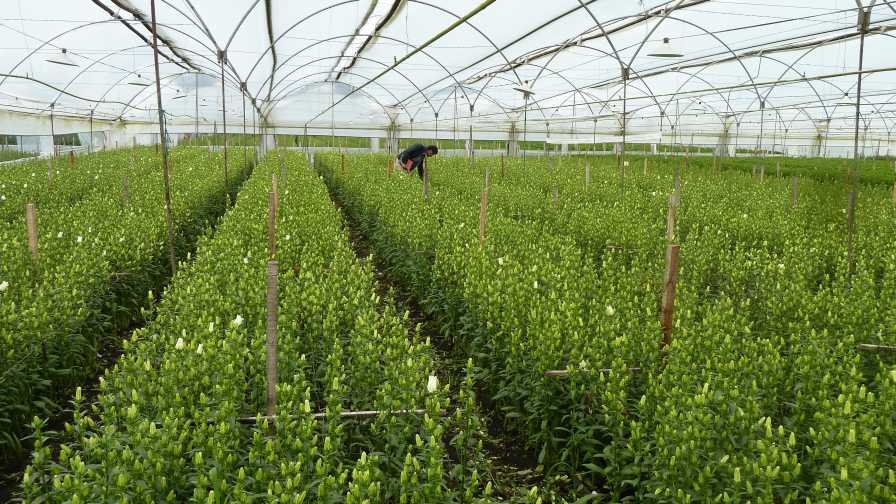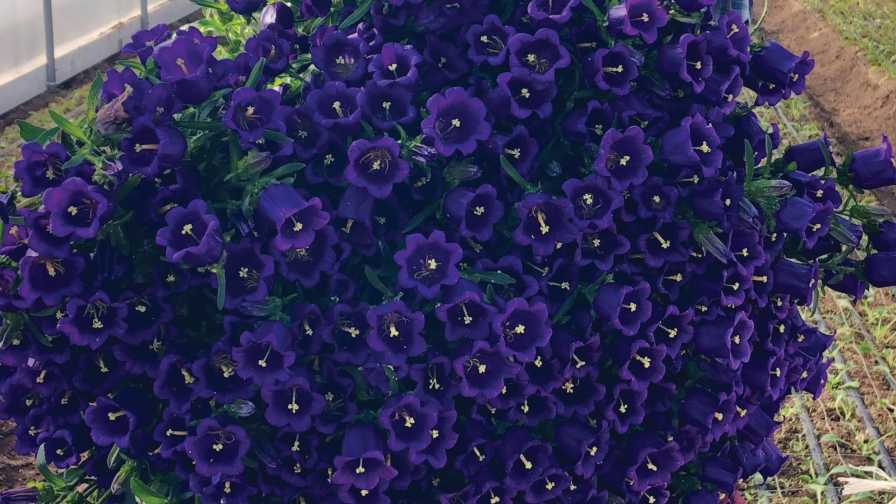Tips for Growing Campanula From Plug To Finish

In general, Campanula ‘Champion’ flowers in 130 to 140 days from sowing.
Photo courtesy of Sakata Ornamentals
Campanula medium, or ‘Canterbury Bells’, offers a unique flower form. Although the flowers look delicate, they are quite strong, ship well, and offer excellent vase life. Campanula Champion and Champion II do not require vernalization and are easy to produce with potential for year-round production, but they also require careful attention to day length.
Both Champion series feature large, sturdy flower cups in beautifully delicate colors. The Champion series includes Blue, Lavender, and Pink, while Champion II offers Deep Blue, Lilac, Pink, Rose, and White.
Plug Culture: Five Weeks (288 Tray)
Media: Select a semi-coarse, well-drained sterile media with a 5- to 20-mm mesh size, as a well-aerated media enhances performance. A pH of 5.8 to 6.2 is ideal.
Sowing: Single sow and lightly cover with medium vermiculite and apply enough moisture to melt the pellet.
Light: Provide short days (more than 12 hours) during plug production to prevent premature flowering.
Temperature: Optimum germination temperature is 65°F to 68°F. Ideally, maintain an even temperature of 68ºF for four days after sowing. Campanula is sensitive to rosette (induced dormancy), so provide moderate temperatures of 68°F to 72ºF during plug production to prevent dormancy.
Fertilizer: Apply 100 ppm nitrogen (N) using a well-balanced calcium nitrate-based fertilizer for healthy and strong plugs. Campanula is sensitive to boron (B) deficiency and requires 0.25 ppm B at each irrigation to prevent a deficiency. EC: 0.26-1.25 mmhos/cm (1:2)/2.1–3.5 (SME)
Plugs are ready when they achieve three true leaves. Campanula medium as a species possesses a tap root structure, and root-bound plants will not produce a healthy and strong plant. To maximize stem length, do not delay transplanting.
Cut Flower Production: 14 to 15 Weeks
For site preparation, start by selecting a bed with good drainage and a soil that is high in organic matter. For best results, provide full sun and good ventilation. pH 6.0-7.0
- Plant Spacing:
Single Stem: 4 to 6 inches apart. Single stem production will crop more quickly and is recommended for greenhouse production.
Multi Stem: 10 to 12 inches apart. Multi-stem production is best for outdoors or in a cold frame. Expect 8 to 10 stems per plant. After transplant, do not allow the plants to dry out in order to prevent tip burn. - Temperature: Ideal growing temperature is 55°F to 60°F.
- Fertilizer: Campanula is not a heavy feeder. Use a well-balanced calcium nitrate-based feed to maintain healthy growth. A lack of boron will cause leaf distortion and tip abortion. A lack of iron will cause tip burn on the leaves. EC: 0.76-1.25 mmhos/cm /2.1-3.5 mmhos/cm (SME).
- Support: Campanula Champion series grows 2 to 2½ feet tall, but support is recommended to avoid damage to plants during windy periods, especially for single-stem production.
- Lighting: Campanula is a long-day-responsive plant and will require lighting for winter flowering. Light the plants when they have eight to 10 true leaves, four to five weeks after transplanting, using mum lighting from 10:00 p.m. to 2:00 a.m. for 40 to 45 days. Cyclical lighting is also effective. No supplemental lighting is required for a late spring flowering (sowing in early February). Under long days, provide short day conditions (less than 12 hours) from sowing until four to five weeks following transplant to ensure enough vegetative growth.
- Crop Time: In general, Campanula Champion flowers in 130 to 140 days from sowing using the above culture. An early August sowing will yield cut flowers in late December to early January if the night temperature is maintained at a minimum of 50°F on the growing point and the crop is lighted for 40 to 45 days starting four to five weeks after transplanting.

Although the flowers of Champion campanulas look delicate, they are quite strong, ship well, and offer excellent vase life.
Photo courtesy of Sakata Ornamentals
Indoor/Outdoor Production Under Long Days
In mild temperature regions (Coastal California, Northwest Upper Midwest, and New England), year-round production is possible with either a black out system or starting with short-day-treated plugs.
- Using a Black out System: During long-day conditions (sowings from late February to early August), maintain short-day conditions (less than 12 hours) in the plug stage continuing until four to five weeks after transplanting with optimum production temperatures.
- Starting with Short-Day Plugs: Sow seed into a 128 to 162 deep plug tray and produce under short days for nine to 10 weeks. Transplant into cut flower beds.
For outdoor production, sow seed either nine to 10 weeks prior to the average last frost date (spring) or nine to 10 weeks prior to the first killing frost (fall).
Overwintering
Transplant mid-sized plugs (128) in mid-September (Zones 5-6) to early October (Zones 7-8) to establish prior to winter with flowering the following spring (May/June). Protect from deer and rabbits with row cover.
- Harvesting: Cut stems when two or three lower buds are open. Dip stems in 100ºF water to reduce latex flow, and then place in tepid water with a bactericide (chlorine tablets). Keep in a cool spot in an upright position to avoid stem bending.
- Postharvest Care: Treat with 1-MCP, as campanulas are quite sensitive to ethylene and pulse with 5% sucrose. Sugar is necessary to encourage the buds to open and develop good color.
- Storage: Cut stems can be stored upright at 36ºF either wet or dry for one week; however, longer storage will reduce the vase life.









